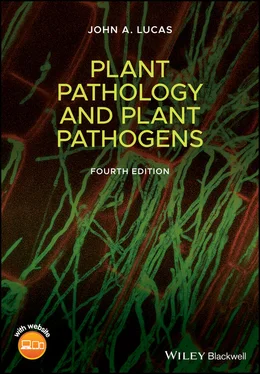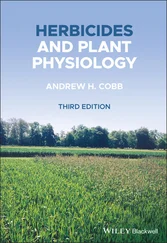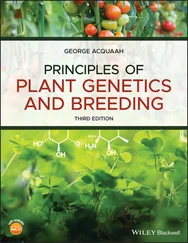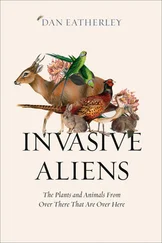In common with all other biological characteristics, host resistance and pathogen virulence are genetically determined. However, these two properties can only be assessed in the presence of the other partner. In the majority of cases, host resistance or pathogen virulence are not obviously correlated with other phenotypic characters. Features of the pathogen, such as rapid and extensive growth or the production of cell wall‐degrading enzymes, may or may not be related to virulence. Assessments of resistance and virulence are therefore based on disease reaction types. An interaction where symptoms are clearly expressed is described as a compatibledisease reaction as opposed to an incompatiblereaction where symptoms do not develop and the effect on the plant is minimal ( Figure 2.6).
Host resistance is controlled by one or a few genes whose individual effects may be easily detected, or by a multiplicity of genes, each of which contributes only a small fraction of the property as a whole. The practical implications of this are described in more detail in Chapter 12. In a few instances, disease reaction type has been shown to be controlled by factors inherited through the host's cytoplasm. The best‐known example of such cytoplasmic inheritance involves the reaction of maize to the leaf blight fungus Bipolaris maydis . In the past, the production of hybrid maize has involved the laborious task of detasselling by hand to avoid self‐pollination occurring. The discovery of a cytoplasmically inherited mitochondrial factor for male sterility ( Cms ), which meant that cross‐pollination was essential, removed the need for this operation. Because of this, cultivars possessing Cms came to predominate throughout the USA. Unfortunately, Cms was also correlated with susceptibility to a particular strain (race T) of B. maydis . As a result, the occurrence in 1970 of favorable conditions for the development of the pathogen resulted in a disastrous epidemic (see Chapter 5, Figure 5.1). In any breeding program, the possibility that the cytoplasm may be important in disease resistance must therefore be considered.
Although pathogen virulence, host resistance, and disease reaction types are genetically determined, the environment may modify the expression of any of these characters. For example, the S r 6 gene conferring resistance in wheat to black stem rust is effective at 20 °C, but is inoperative at 25 °C.
From an evolutionary viewpoint, it is predictable that genetic systems determining virulence in the pathogen will be paralleled by genes conferring resistance in the host. This is because any mutation to virulence in a pathogen population will be countered by the selection of hosts able to resist this more aggressive pathogen. Evolutionary biologists describe such a dynamic process of complementary changes as an “arms race.” Thus, in an ideal world we might envisage a perpetual stalemate, with host and pathogen populations being closely matched in resistance and virulence. Hence over a period of several years disease would be neither completely absent nor would it become rampant.
Support for these ideas has been obtained by field observations and experimental studies on several plant pathosystems. The planting of crop cultivars containing a limited number of specific resistance genes will tend to select for pathogen strains possessing complementary virulence. Strains of a pathogen which differ in specific virulence genes are usually called races. The races present in any one season or in a particular locality may be identified by their behavior on a selection of cultivars carrying different combinations of genes conferring resistance. A hypothetical interaction between several races of a pathogen and a differential set of host cultivars is shown in Table 2.3.
Further analysis of such differential interactions has shown that there is a precise genetic relationship between the two partners. The pioneering study was done by Harold Flor, who analyzed the genetics of host resistance and pathogen virulence using flax rust, Melampsora lini , as a model. Flor showed that for each host gene conferring resistance, there is a complementary gene in the pathogen determining virulence. This finding has become widely known as the gene‐for‐gene theoryof host–pathogen interactions. On the basis of Flor's theory, the possible interactions between a pair of alleles governing resistance in a plant and the corresponding pair determining virulence in the pathogen can be shown as a quadratic check ( Figure 2.7). In this scheme, a resistant reaction occurs only where an allele for resistance in the host plant interacts with an allele for avirulence in the pathogen.
Table 2.3 Hypothetical interaction between four host cultivars and four pathogen races
| Host |
Pathogen |
| Race 1 |
Race 2 |
Race 3 |
Race 4 |
| Cultivar 1 |
+ |
− |
− |
− |
| Cultivar 2 |
− |
+ |
− |
− |
| Cultivar 3 |
− |
− |
+ |
− |
| Cultivar 4 |
− |
− |
− |
+ |
+ = compatible disease reaction (host susceptible, pathogen virulent).
− = incompatible disease reaction (host resistant, pathogen avirulent).

Figure 2.7 The quadratic check, showing interactions between alleles of a host resistance gene and a pathogen gene for avirulence. Resistance ( R ) and avirulence ( A ) are usually dominant.
More recent analysis of mechanisms of pathogenicity in some necrotrophic fungi has shown that host susceptibility can in some cases be determined by the interaction of a pathogen toxin with a plant receptor causing sensitivity to this toxin. In such cases, susceptibility is the dominant trait, and the interaction has been described as an “inverse gene‐for‐gene” model (see Chapter 10, Figure 10.10).
The gene‐for‐gene theory has important practical implications. The sequential introduction of new host cultivars which differ in resistance genes has been accompanied by corresponding changes in pathogen populations, whereby new races have successively come to predominate. The implications of this will be discussed further in Chapter 12. The gene‐for‐gene theory is also an important starting point for molecular models of host–pathogen specificity. Where single genes determine the outcome of a particular interaction, identification of the gene products involved should clarify how host–pathogen recognition occurs. Progress toward this goal is described in Chapter 10.
1 Nash, A., Dalziel, R., and Fitzgerald, J. (2015). Mims Pathogenesis of Infectious Disease. Washington, DC: Academic Press.
2 Smith, S.E. and Read, D.J. (2010). Mycorrhizal Symbiosis, 3e. Washington, DC: Academic Press.
1 Andrivon, D. (1993). Nomenclature for pathogenicity and virulence: the need for precision. Phytopathology 83: 889–890. (and subsequent correspondence. See Phytopathology 85: 518–519, 1995).
2 Cooke, R.C. and Whipps, J.M. (1980). The evolution of modes of nutrition in fungi parasitic on terrestrial plants. Biological Reviews 55: 341–362.
3 Crute, I.R. (1994). Gene‐for‐gene recognition in plant‐pathogen interactions. Philosophical Transactions of the Royal Society of London. Series B, Biological Sciences 346: 345–349.
Читать дальше












